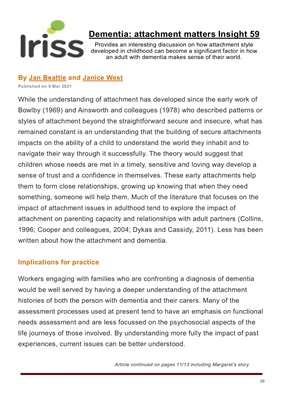
10
By Jan Beattie and Janice West
Published on 9 Mar 2021
While the understanding of attachment has developed since the early work of
Bowlby (1969) and Ainsworth and colleagues (1978) who described patterns or
styles of attachment beyond the straightforward secure and insecure, what has
remained constant is an understanding that the building of secure attachments
impacts on the ability of a child to understand the world they inhabit and to
navigate their way through it successfully. The theory would suggest that
children whose needs are met in a timely, sensitive and loving way develop a
sense of trust and a confidence in themselves. These early attachments help
them to form close relationships, growing up knowing that when they need
something, someone will help them. Much of the literature that focuses on the
impact of attachment issues in adulthood tend to explore the impact of
attachment on parenting capacity and relationships with adult partners (Collins,
1996; Cooper and colleagues, 2004; Dykas and Cassidy, 2011). Less has been
written about how the attachment and dementia.
Implications for practice
Workers engaging with families who are confronting a diagnosis of dementia
would be well served by having a deeper understanding of the attachment
histories of both the person with dementia and their carers. Many of the
assessment processes used at present tend to have an emphasis on functional
needs assessment and are less focussed on the psychosocial aspects of the
life journeys of those involved. By understanding more fully the impact of past
experiences, current issues can be better understood.
Article continued on pages 11/13 including Margaret's story
Dementia: attachment matters Insight 59
Provides an interesting discussion on how attachment style
developed in childhood can become a significant factor in how
an adult with dementia makes sense of their world.